Imagine a guitar that perfectly fits your strumming hand with just the right balance between a crisp tone and soulful melody – that, my friends, is the essence of the Taylor 110e acoustic-electric guitar. Hi, I’m Richard Miller, a guitar enthusiast who’s spent most of his life mastering the art of the six strings. My journey may have started at the tender age of six with a mere curiosity, but, today, it has evolved into a full-fledged passion for the craft. Taylor 110e has been a part of this journey, and I believe it deserves a detailed breakdown.
The Taylor 110e is more than just a guitar; it’s an experience that demands a deep dive. In my years as both a professional musician and an educator, I’ve discovered its unique versatility and adaptability, which I aim to share with you. Just as a teaser – did you know it’s equally appeasing to both novice and seasoned guitarists? But, that’s just the tip of the iceberg.
We will delve into an all-encompassing inspection, from the impeccable craftsmanship that goes into its shape and materials to the intricacies of its electronic attributes. You’ll become an expert on its sound quality, resonate with Taylor’s unique sound, and appreciate the impression of ES2. This comprehensive guide will also include a sneak peek into user reviews, of course, through my lens.
The world of Taylor 110e is brimming with revelations that are sure to stir the musician in you – whether you’re strumming it for the first time, or it’s your companion in gigs.
I cordially invite you to join me as I explore the spectrum of this acoustic-electric wonder and why it’s considered one of the finest guitars in the market today. Ready for the symphony? Let’s strike the chords.
Features
Shape and Materials
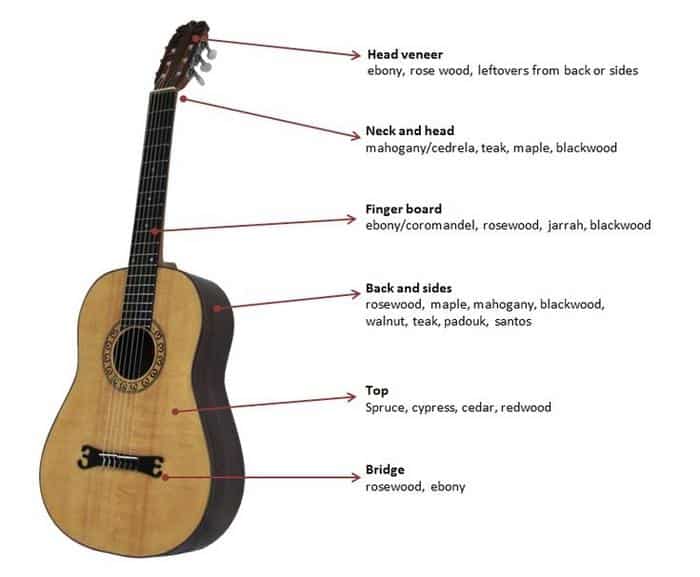
The significance of a guitar’s shape and materials can’t be overstated. Over time, I’ve learned that these features largely define the sound and playability of the instrument. Allow me to elaborate using the Taylor 110e as a prime example.
The charming dreadnought shape of the Taylor 110e acoustically amplifies lower frequencies, delivering a powerful, hard-hitting tone that’s perfect for strummers and flatpickers alike. The shape contributes to a well-defined, voluminous sound — a favorite feature for many musicians.
Let’s talk about materials. The Sitka spruce top lends its character to the overall sound profile of the guitar. Its strength-to-weight ratio allows it to be thin yet robust, providing a broad dynamic range and crisp articulation. This top quality spruce means you can play more energetically without compromising the sound clarity.
The back and sides of the guitar are made of layered walnut. It’s a beautiful material that results in powerful, focused tones with plenty of projection. Layered wood also has the advantage of being resistant to changes in temperature and humidity, making the guitar more durable in diverse environments.
In essence, the blend of a dreadnought shape with a Sitka spruce top and layered walnut back and sides ensures the Taylor 110e delivers a rich, robust sound while remaining consistently playable regardless of location and condition. Therefore, shape and materials significantly contribute to the overall experience and potential of this amazing instrument.
Electronics

Moving deeper into the features of the Taylor 110e, it’s high time we zeroed in on the electronics – an aspect I can confidently attest to its criticality, drawing from my vast experience of live performances. The soul of this guitar’s electronics lies in the ES2 electronics system. Known for its fantastic reproduction of the acoustic sound, the ES2 system breathes life into the Taylor 110e when you plug it in, ensuring your performances always hit the right note.
The ES2 electronics system from Taylor is a standout feature in the acoustic-electric guitar market, ensuring that the sound you get while unplugged remains virtually unchanged when amplified. The under-saddle transducers are strategically positioned to capture all the dynamics of your playing, providing clarity and balance across the auditory spectrum. As an artist, the true power of your performance is revealed with this system.
Now, let’s consider the battery life in acoustic-electric guitars, undoubtedly an essential aspect. The ES2 system’s energy efficiency comes into play here. Based on my observation, you’ll find that the Taylor 110e typically offers several performances before requiring a battery change. This reliable battery life can make a world of difference, especially during those long jamming sessions or gigs where you don’t want interrupted sound.
To wrap this section up, seconds to the playability, the ES2 electronics system, and its prolonged battery life contribute significantly to the overall appeal of the Taylor 110e, adding a new dimension to your music, be it unplugged or amplified.
Sound Quality
Taylor’s Unique Sound
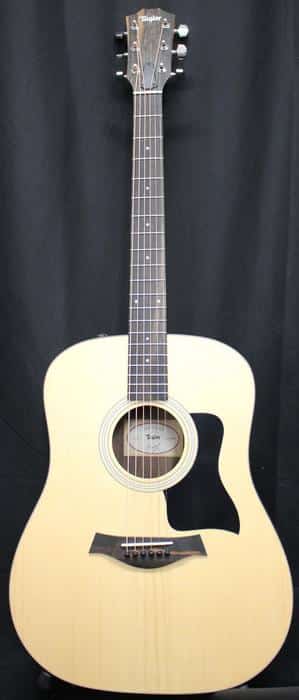
Having spoken about the sound quality of the Taylor 110e, it’s important to delve deeper into what sets it apart – Taylor’s signature sound. This distinct sound quality was one of the factors that truly endeared me to Taylor acoustic guitars. Their distinct tone has, undoubtedly, played a part in shaping my musical journey.
From brilliant highs to rich, resonant lows, the iterative nuances in Taylor’s signature sound are captured beautifully by the Taylor 110e. It is this unique, balanced acoustic guitar tone that sets Taylor Guitars apart in a crowded marketplace. This unique blending of tones means you can easily transition from a fingerpicking style to strumming power chords, with each note retaining a clarity that is an absolute joy to the ears.
The contribution of Taylor’s unique sound to the overall sound quality of their guitars cannot be overstated. It provides a warmth and brightness that elevate every chord and strum into an experience. This isn’t a sound that’s manufactured – it’s carefully crafted, and you can hear that in every note.
As we transition to discuss my impression of the ES2, let’s keep in mind how Taylor’s signature sound plays into their electronics. The ES2 is another example of Taylor’s dedication to delivering quality sound – a topic I’m eager to delve into.
Impression of ES2
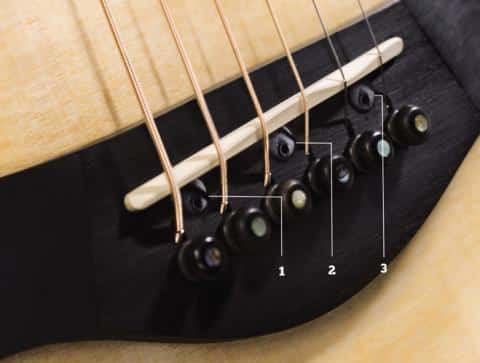
Moving onto the significance of the Taylor 110e’s sound quality, the integration of the Expression System 2 plays a pivotal role. As someone who has utilized numerous acoustic-electric guitars, I can vouch for the unique capabilities of the ES2. After years of experimentation and experience, it’s evident that ES2 enhances performance levels significantly by adding a depth of sound few systems can rival.
The Expression System 2 is a highly resonant electronic setup that enriches the acoustic quality intrinsically linked to Taylor guitars. It elevates the sound, capturing the guitar’s dynamic range in a manner that feels intuitive and organic. Its positioning behind the saddle, rather than underneath it, allows for a broader dynamic range and a more natural acoustic response. The ES2 blends seamlessly with the guitar’s design, maintaining hallmark Taylor tonality while introducing a new dimension of sound quality.
In essence, the ES2 contributes excellently to the sound quality of the Taylor 110e; it provides a natural, richer, and more nuanced sound. This amplifying feature is a real game-changer, adding immeasurable value to the instrument. Therefore, the relevance and contribution of ES2 to the overall sound quality of the Taylor 110e are undeniable.
Playability
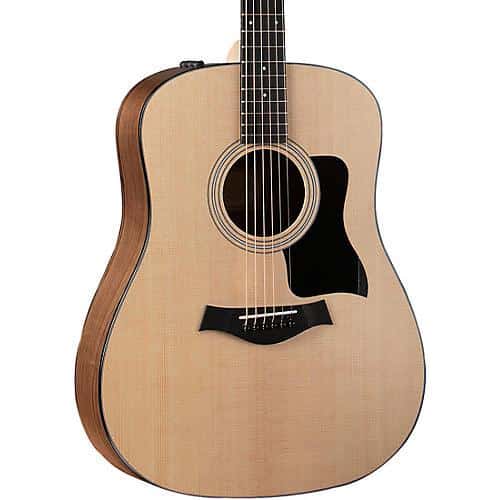
Undoubtedly, for every passionate guitarist—be it a beginner learning the ropes or a seasoned musician perfecting their artistry—the playability of their instrument holds prime importance. My journey, as an experienced fingerstyle guitarist, has made me believe that a guitar’s playability can make or break your creative experience. And when discussing playability, the Taylor 110e guitar continues to be a topic of delightful conversation in music circles.
Why is the Taylor 110e revered by both beginners and seasoned musicians for its playability? This intriguing question tracks back to the design philosophy and innovative craftsmanship that Taylor has nurtured over the years. The Taylor 110e rests on the delicate balance of comfort and flexibility, a combination that proves essential for enhancing your chord progressions and unraveling new creative freedoms.
It’s worth noting how this guitar minimizes chording difficulty. Having played numerous guitars over the years, I can vouch for the smoothness of the 110e neck profile. The well-crafted fretboard and manageable string action significantly reduce chording difficulty, encouraging you to try complex patterns and experiment with different musical styles. While playing, the Taylor 110e feels like an extension of your musical aspirations, rather than a limiting physical tool.
Beyond accessibility in playing, an often overlooked aspect of playability is the guitar setup and maintenance. Here’s where the Taylor 110e shines again. Owing to its durable build quality and uncomplicated setup, it demands minimal maintenance. This accessibility extends the life of the instrument, assuring that its splendid playability remains unhindered over the years. And, when fewer distractions arise due to setup and maintenance issues, the player can fully immerse themselves in the joy of making music.
In sharing my experiences, I hope that I’ve managed to relay the essence of the guitar playability that the Taylor 110e offers. Its exceptionally user-friendly design, paired with the ease of maintenance, paints a whole picture of playability.
However, the allure of this guitar doesn’t stop here. We will dig deeper into its other remarkable attributes and how they seamlessly blend into the overall User experience in the following sections. To further discern the capability of this magnificent instrument, we will consider feedback from other users and provide thoughtful considerations for potential buyers.
User Reviews
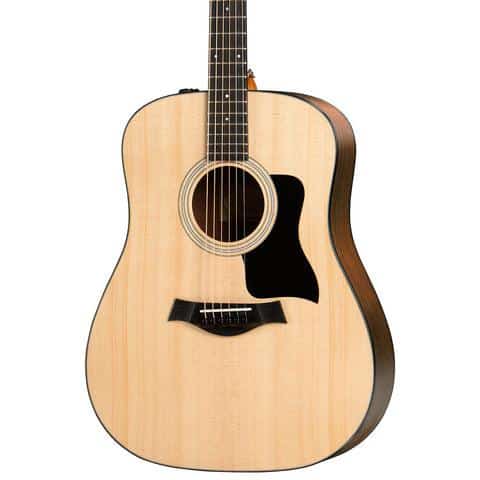
Engaging with the guitar community over the years has given me a broad perspective on various user experiences. I’ve interacted with novices, hobbyists, and professional musicians, picking up their stories, triumphs, and complaints about different guitars. This broad spectrum of interactions, combined with my personal experiences, has provided me with a unique insight into the fascinating world of guitars. And the one guitar that has consistently caught my attention, for good reasons, is the Taylor 110e.
Perhaps a question you might have is, “What do actual users say about the Taylor 110e? Any love stories or horror stories?” From my extensive engagement on guitar forums and community discussions, and perusing numerous guitar reviews, it’s clear to me that the Taylor 110e has found a special place in many guitarists’ hearts.
Most players comment on its outstanding playability, praising its comfortable neck and the ease with which they can form chords and slide through the fretboard. The guitar’s beautifully balanced sound is another major highlight. Artists appreciate its rich, clear tone and the amplification system that never seems to distort or color the sound, regardless of playing volume.
Quality and robustness have also been repeatedly lauded, with users expressing satisfaction with the guitar’s durability and longevity. Little surprise really, given Taylor’s reputation for excellent craftsmanship. This explains why the 110e has garnered much love, often becoming a lifelong partner for some people, seen as an essential part of their musical journey and growth.
Yet, this wouldn’t be a comprehensive review without mentioning some criticisms too. A few players have spoken about how the upsides come with a relatively steep price tag. It isn’t exactly a budget guitar, making it a significant investment for beginners. And while almost everyone appreciates the sound, there have been comments suggesting it doesn’t quite have the warm, mellow tone of some traditional acoustic guitars. Lack of a pickguard, too, has been marked as a negative by quite a few.
In conclusion, while the 110e may not be perfect in everyone’s eyes, the positive reviews far outweigh the negatives. As someone who’s been playing this guitar for a significant period, I can wholeheartedly vouch for the majority sentiment. Whether you’re a budding guitarist or a seasoned professional, this instrument is worth considering. But it’s always prudent to try one out for yourself before buying – after all, every musician has unique needs and preferences.
Buying Guide
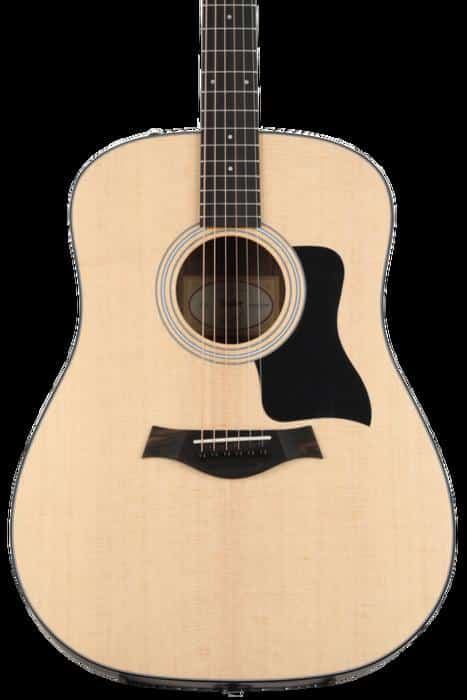
Acquiring a new guitar is an exhilarating venture. The moment you unbox it, the first strum, the unique resonance – it’s a euphonic symphony of experiences. It becomes an extension of your own being, mirroring your soul’s harmony. I believe I can guide you through this journey. If guitar selection was a song, I have mastered its chords over the years.
Speaking of mastery, let’s talk about the Taylor 110e. Part of the challenge when buying a guitar is choosing one that aligns with your budget, resonates with your musical inclination, and enhances your performance potential. Affordable guitars should not compromise on sound, quality, or comfort, and the Taylor 110e meets all these criteria.
Looking to buy a Taylor 110e? Let’s navigate the guitar market together. I’ll use my extensive knowledge, rooted in experience and passion, to highlight why this versatile beast is worth considering.
Having seen the guitar market evolve from my early years as a music enthusiast to being a recognized guitarist, I’ve distinguished the quintessence from the mundane. Taylor 110e stands out because it combines affordability and versatility without diluting the enchanting expressiveness of your tunes.
Let me share some guitar purchase advice with you. Do not sway with popular sentiments. Every musician has unique needs and preferences. It’s crucial to buy a guitar that feels good to hold, comfortable to play, and resonates with your musical soul. This balance of personal comfort, sound quality, and budget is what makes Taylor 110e a worthy consideration.
The Taylor 110e serenades its admirers with a robust yet balanced sound, marrying the sonic richness with an unassailable playability. It brings together the best elements of quality, affordability, and comfort.
Whether you’re an eager beginner or a seasoned professional, the Taylor 110e could very well be your trusty companion on this musical journey. Keep reading, and I’ll help you get acquainted with this intricate instrument, beckoning you to explore the unchartered territories of your musical potential.
FAQs
Is Taylor 110e suitable for professional musicians?
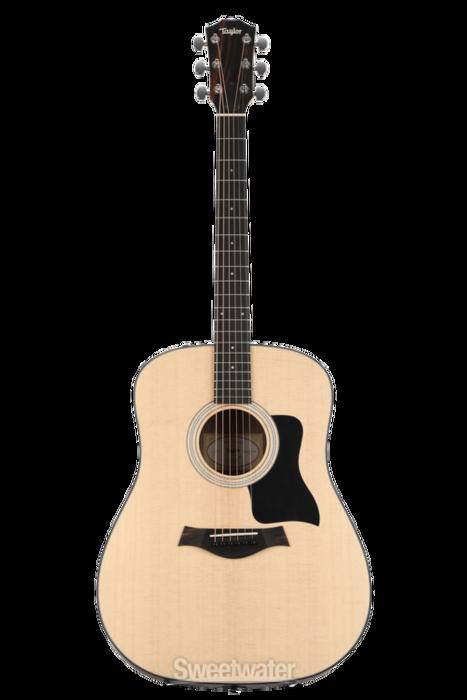
As a professional guitarist, I’ve come to understand the multifaceted requirements professional musicians have concerning their instruments. With its diverse range of sound quality, ease of playability, and refined craftsmanship, the Taylor 110e goes beyond mere suitability—it’s a genuine delight for professionals. This guitar offers versatile adaptability and high-caliber innovation, making it an invaluable addition to your repertoire, regardless of your musical style.
Within this ‘Buying Guide’, we’ve navigated the sound qualities and unique features of the Taylor 110e. By now, you should be fully equipped to make an informed decision about its relevance to your professional musical journey. Remember, investing wisely in your instrument is integral to your musical progression.
Is the Taylor 110e a good practice option?
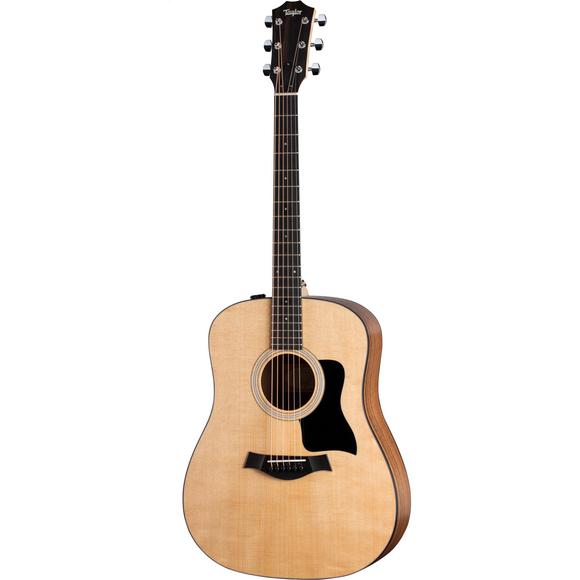
Shifting our focus to the practicality of the Taylor 110e, let’s consider its potential as a guitar practice option. Drawing on my experience as an educator and mentor for countless musicians, I can confidently assert its exemplary suitability for practice sessions. The Taylor 110e seamlessly caters to learners working on their chord transitions and strumming patterns, while also being a reliable companion for professionals warming up pre-gig. Its comfortable playability, paired with the authentic and resonant tones it produces, makes it an inspiring practice tool.
Recall the unique sound and playability sections, wherein we emphasised the guitar’s versatility and simplicity. These elements converge, making the Taylor 110e a viable practice option that encourages consistent progress and true musical expression. This guitar doesn’t just mirror your skill level, it enhances your learning experience, making your practice sessions more productive.
Conclusion
So, why exactly does the Taylor 110e stand out in the crowded guitar marketplace? Drawing on my extensive experience with different guitars, I’ve found that the Taylor 110e acoustic-electric guitar’s compelling mix of features, sound quality, and affordability separates it from competitors.
The overall guitar sound comparison of various models and brands proved that Taylor 110e’s unique sound, contributed by its shape and materials, makes for an unrivaled playing experience. The impression of ES2 electronics was notable, improving sound quality and playability even further.
Throughout this guide, I’ve shared insights and nuances based on user reviews and my own experience. As a professional musician or someone looking for a good practice guitar, the Taylor 110e meets a wide range of needs. It offers a perfect balance, making it a worthy investment even in a competitive field.
To wrap up, the Taylor 110e’s holistic combination of superior sound, comfortable playability, and accessible pricing fulfils many aspects of a comprehensive buying guide, making it a standout choice. Remember, it’s not just about making music—it’s about savouring every note, and the one-of-a-kind experience that the Taylor 110e offers is simply incomparable. This indeed is the magic of music unfolded through the strings of the Taylor 110e.